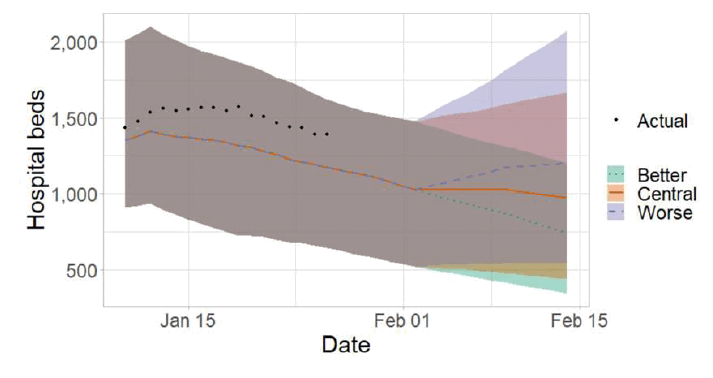Coronavirus (COVID-19): state of the epidemic - 28 January 2022
This report brings together the different sources of evidence and data about the Covid epidemic to summarise the current situation, why we are at that place, and what is likely to happen next.
This document is part of a collection
Looking ahead
Scottish Contact Survey
Changes in patterns of mixing and adherence to restrictions will impact on future case numbers. The Scottish Contact Survey measures times and settings that people mix where they could potentially spread Covid-19. Average contacts from the most recent Panel B cohort of the Scottish Contact Survey (week ending 19 January) indicate an average of 5.0 contacts. This is an increase of 35% compared to two weeks prior.
Mean contacts have increased within the work and other setting (contacts outside home, school and work) by 59% and 10% respectively in the last two weeks. Contacts within the home have decreased by 7% levels over the same period.
The biggest increase was observed in the 30-39 age group where overall contacts increased by approximately 89%. This increase is largely driven by a rise in contacts within the work setting.
Modelling the Epidemic
The latest Modelling the Epidemic report includes projections over the next few weeks for combined Delta and Omicron infections. These projections include the effect of the interventions announced on 14 and 21 December 2021; those announced as being lifted from 17, 24 and 31 January 2022; and booster take up. With this taken into account, it is estimated that daily infections may be between 5,000 and 60,000 in mid-February[71].
The report also provides the impact of the projections on the number of people in hospital and ICU. Figure 14 shows the impact of the daily infection projections on the number of people in hospital. The modelling includes all hospital stays, whereas the actuals only include stays up to 28 days' duration that are linked to Covid-19. However, there continues to be uncertainty over hospital occupancy and intensive care in the next three weeks. In this figure, the 'Central' scenario assumes that infections broadly plateau at current levels. The 'Worse' scenario assumes a higher transmissibility for Covid-19 whereas the 'Better' scenario assumes a lower transmissibility. All projections also assume a lower vaccine effectiveness for Omicron than for Delta[72].

Long Covid
According to the Office for National Statistic (ONS), long Covid is defined as symptoms persisting more than four weeks after the first suspected coronavirus (Covid-19) episode that are not explained by something else.
The ONS Covid-19 Infection Survey estimated that 1,266,000 people (95% confidence interval: 1,228,000 to 1,304,000) in the private residential population in the UK (1.96%; 95% CI: 1.90% to 2.02%) reported experiencing long Covid over the four-week period ending 6 December 2021. In Scotland, over the same period, an estimated 100,000 people (1.90% of the respective population) in the private residential population reported experiencing long Covid of any duration. This compares to 1.98% in England, 1.91% in Wales and 1.57% in Northern Ireland[74].
Scottish Government modelling of long Covid estimates that at 13 February 2022, between 63,000 (1.1% of the population) and 162,000 (3.0%) people are projected to self-classify with long Covid for 12 weeks or more after their first suspected Covid infection in Scotland[75]. These are preliminary results, further data on rates of long Covid and associated syndromes as research emerges are required.
Contact
There is a problem
Thanks for your feedback